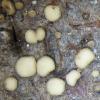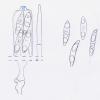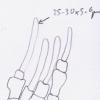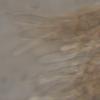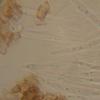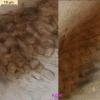
07-12-2025 16:07
Arnold BüschlenHallo, ich habe in einer Moos-Aufsammlung (epiphy

08-12-2025 21:04
Mark Stevens"Hello everyone,I'm relatively new to microscopy (

09-12-2025 12:06
 Andgelo Mombert
Andgelo Mombert
Bonjour,Je recherche l'article concernant Hypobryo

08-12-2025 18:59
 Lothar Krieglsteiner
Lothar Krieglsteiner
.. found by a seminar-participant, I do not know t

08-12-2025 17:37
 Lothar Krieglsteiner
Lothar Krieglsteiner
20.6.25, on branch of Abies infected and thickened

16-03-2014 22:00
Hello,I found this species a few months ago but ha

08-12-2025 13:39
Thomas Læssøehttps://svampe.databasen.org/observations/10572899
asco sp.
Yannick Mourgues,
31-08-2009 00:41
 Bonsoir.
Bonsoir.Qui peut m'aiguiller sur cette récolte ?
Macro :
Ascomes sur écorce de Betula, sur branche morte encore en place à 2m de hauteur. diamètre <1,5mm.
Hyménium blanchâtre à crème brunissant lélèrement vers la marge.
Excipulum brun-grisâtre couvert de poils blanchâtres.
Micro :
Spores fusiformes parfois arquées, avec en général 2 guttules mais parfois jusqu'à 5.
19,8-21,3x3,6-5,2 um spores bisériées
Asques IKI+ à sommet "boursouflé" (y a t-il un terme pour cette forme ? Cf. dessin joint), 80-110x8-9 um, issus de boucles
Paraphyses filiformes se terminant en pointe, septées, sans contenu huileux, large de 2-3 um.
Poils de l'excipulum : cf photo.
Textura intrica avec des cellules devenant brunes vers l'excipulum.
Une idée ?
Hans-Otto Baral,
31-08-2009 11:18

Re:asco sp.
Hi Yannick
looks for a species around Hymenoscyphus fuscidulus. I would term the ascus apex mammiform. Very important would be the content of the living paraphyses, I assume they contain strongly refractive vacuoles. Also I doubt that they are normally pointed. Could you please verify this?
The ectale excipulum seems of globulosa. It would be good to have a picture of unstained cells with their natural pigment.
Also the drawn spores are dead, do you have the fungus only in the dry state?
Cheers
Zotto
looks for a species around Hymenoscyphus fuscidulus. I would term the ascus apex mammiform. Very important would be the content of the living paraphyses, I assume they contain strongly refractive vacuoles. Also I doubt that they are normally pointed. Could you please verify this?
The ectale excipulum seems of globulosa. It would be good to have a picture of unstained cells with their natural pigment.
Also the drawn spores are dead, do you have the fungus only in the dry state?
Cheers
Zotto
Yannick Mourgues,
31-08-2009 11:51

Re:asco sp.
Thank's Zotto.
Yes, unfortunately my fungus is dry now.
I looked for refractive vacuoles in paraphyses when it wasn't dry, but I saw nothing. Is-it possible to see them when dry ? May be all collapsed.
I try to make a picture of ectale excipulum now.
Yannick
Yes, unfortunately my fungus is dry now.
I looked for refractive vacuoles in paraphyses when it wasn't dry, but I saw nothing. Is-it possible to see them when dry ? May be all collapsed.
I try to make a picture of ectale excipulum now.
Yannick
Hans-Otto Baral,
31-08-2009 12:36

Re:asco sp.
These fungi are entirely xerointolerant, therefore these VBs totally disappear.
What you can try is a photo of the IKI-stained ascus apex. The H. fulvidulus group has a speciel rather conspicuous apical ring, unlike typical Hymenoscyphus.
Zotto
What you can try is a photo of the IKI-stained ascus apex. The H. fulvidulus group has a speciel rather conspicuous apical ring, unlike typical Hymenoscyphus.
Zotto
Yannick Mourgues,
31-08-2009 16:38
Hans-Otto Baral,
01-09-2009 00:16

Re:asco sp.
O.k., the drops in the paraphyses are possibly oil. The tips are indeed a bit tapered. If the spores were not that large I would even suggest a Mollisia. But also the oil in the paraphyses seems unusual for a Mollisia.
Zotto
Zotto
Yannick Mourgues,
01-09-2009 00:18

Re:asco sp.
Thanks Zotto. I put it on the rubbish-bin ?
Hans-Otto Baral,
01-09-2009 00:20

Re:asco sp.
I think this is a very interesting collection, perhaps a rare species. A pitty that we do not have its vital characters.
Zotto
Zotto
Yannick Mourgues,
01-09-2009 00:35

Re:asco sp.
Do you want me to send it to you ?
Yannick
Yannick
Hans-Otto Baral,
01-09-2009 15:17

Re:asco sp.
If you wish you can do. I can at least try what I can.
Zotto
Zotto
Hans-Otto Baral,
05-09-2009 13:13

Re:asco sp.
Now we come to a better result. I received today the wonderful specimen though in the dry state (only part of the spores were alive. It is clearly a Mollisia (!, e.g., because of the Calycina-type of apical ring, the amyloid zones being apicallywidest), and very close to M. ramealis (= Dibeloniella citrinella). I did not come to a result with Andreas' english key. The only difference to M. ramealis seems to me to be in spore spize, being much too short, and a bit too wide.
My data: Asci KOH 98-107 x 8.3-9 µm, with croziers, IKI 3rb (distinctly red!), Calycina-type. Sp. *19-21.5 x 3.7-4 µm. Paraph. KOH 3-3.8 µm wide, not or slightly obtusely lanceolate. Hymenium KOH-. Medulla very loose t. intricata, with a few some crystal druses.
The large drops in the spores are obviously a product of drying since I found some spores with a purely multiguttulate content. They then resemble those of Hymenoscyphus menthae.
So please tell me the collection data. Is the bark actually Betula? It does not at all look white. You found it on a hanging, still-attached branch?
Zotto
My data: Asci KOH 98-107 x 8.3-9 µm, with croziers, IKI 3rb (distinctly red!), Calycina-type. Sp. *19-21.5 x 3.7-4 µm. Paraph. KOH 3-3.8 µm wide, not or slightly obtusely lanceolate. Hymenium KOH-. Medulla very loose t. intricata, with a few some crystal druses.
The large drops in the spores are obviously a product of drying since I found some spores with a purely multiguttulate content. They then resemble those of Hymenoscyphus menthae.
So please tell me the collection data. Is the bark actually Betula? It does not at all look white. You found it on a hanging, still-attached branch?
Zotto
Hans-Otto Baral,
05-09-2009 13:15
Hans-Otto Baral,
05-09-2009 13:20
Yannick Mourgues,
07-09-2009 00:17

Re:asco sp.
Thank's a lot Zotto.
I found this Mollisia on a died branch, still in place, in 2m from height, on Betula.
All the bark of this Betula was not completely white, but I am sure that it was a Betula.
The collection is from "Forêt Communale de Pelouse", Pelouse (48000-Lozère-France), 26/08/2009.
Is-it possible to have these tree pictures in highter resolution ?
Yannick
I found this Mollisia on a died branch, still in place, in 2m from height, on Betula.
All the bark of this Betula was not completely white, but I am sure that it was a Betula.
The collection is from "Forêt Communale de Pelouse", Pelouse (48000-Lozère-France), 26/08/2009.
Is-it possible to have these tree pictures in highter resolution ?
Yannick
Hans-Otto Baral,
07-09-2009 00:51

Re:asco sp.
Thanks, Yannick,
yes, I send you my images by email
Zotto
yes, I send you my images by email
Zotto

